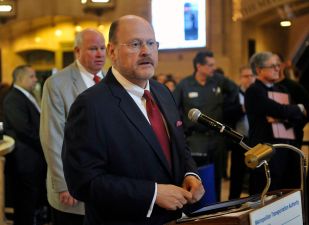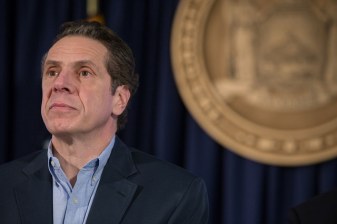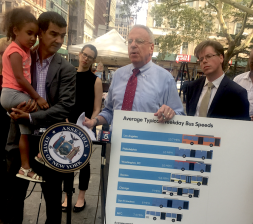Joe Lhota: The MTA Needs New Tax Revenue

The MTA needs new revenues, announced chairman Joe Lhota during a broad-ranging panel discussion at Fordham University this morning. “There’s going to be the need for broad-based tax revenue somewhere within the system over the next couple of years,” Lhota said, noting that he’s generally the kind of conservative person loath to call for tax increases.
In calling for new revenues, the new transit chief gave notice that the system can’t succeed by cutting costs alone. While Lhota said little about specific revenue sources, bridge tolls or congestion pricing don’t seem to be high on his list.
Both Lhota and his co-panelist, Port Authority Executive Director Pat Foye, spoke at length about the need to expand the transit system in the New York region. “Brooklyn is the new Hicksville. Queens is the new Stony Brook,” said Foye, referring to Long Island suburbs whose population boom is past. Arguing that the new urban residents would likely be “even greater consumers of mass transit,” he called for greater investment in the public transportation system.
“We have the need for funding for the ongoing needs, we also have the need for funding for the growth that’s going on,” agreed Lhota. To pay for that growth, Lhota repeatedly said that some form of new tax revenue would be necessary. “The money coming from Albany, coming from the feds is reducing, and the pressure on tolls is increasing,” he said.
Though he declined to discuss specific revenue streams, Lhota said that “an expansion of the sales tax, the small proportion that’s received, would be very very helpful, would go a long way.” The existing 0.375 percent regional MTA sales tax netted the transit authority as much as $803 million in 2009, according to the Independent Budget Office.
Lhota and Foye both expressed skepticism about using toll increases to fund transit and other important infrastructure investments. Lhota said that biennial toll increases were part of the MTA’s long-term budget moving forward, but worried the levels were already too high. “I’m concerned about the level that we have on the bridges right now,” he said, “because they are extremely high and are reducing economic growth and economic development in the region.” Foye seemed supportive of the Port Authority toll hikes passed under his predecessor, Chris Ward, but worried about “upper limits on tolling authorities in this country’s ability to pass tolls along.”
Lhota and Foye instead pointed to public-private partnerships and tax-increment financing as ways to raise needed revenues, prompting a debate with the panel’s moderator, former MTA chairman and lieutenant governor Richard Ravitch. After Foye praised Canada, among other nations, for extensive use of private infrastructure financing, Ravitch replied, “There’s no such thing as a tax-protected security in Canada,” meaning that the government, unlike in America, doesn’t have an inherent ability to borrow money at a lower cost than the private sector. “Why wouldn’t you finance it tax-exempt?” Ravitch asked. Foye responded that the private sector should only be brought in if they had something to offer besides capital, such as particular technical expertise or the ability to absorb the financial risk of project costs.
Lhota added that public authorities, including the MTA, had little ability to borrow more money. “We’re almost at a capacity limitation right now unless there’s additional revenues.” The Cuomo administration is proposing a major increase in the MTA’s debt ceiling due to the significant borrowing needed to pay for repairs and system expansions without new revenues. It would be the first time the MTA’s debt ceiling has been raised so soon after the last increase, which was enacted in 2010.
Tax-increment financing, which attempts to capture the increase in real estate values created by new infrastructure (the city is using it to fund the extension of the 7 train to Hudson Yards), didn’t receive the same kind of pushback. According to Foye, TIFs can’t be used in most of New York without a change to state law. Lhota pointed to developments planned for the route of the Second Avenue Subway to make the case for using TIFs to help pay for new infrastructure.
Lhota also previewed what could be the next front in the labor-management battles at the MTA, once the TWU contract is completed. After Lhota discussed his goal of further integrating operations between the Long Island Railroad, Metro-North and New York City Transit, Ravitch raised one potential obstacle to integration. Workers on the LIRR and Metro-North are covered by the federal Railroad Labor Act, while transit authority workers are subject to the state’s less labor-friendly Taylor Law. Ravitch himself tried to cover the railroads under the state labor regime, only to be rebuffed by the United States Supreme Court in 1982.
Now, however, Lhota suggested that he might attempt to get that decision overturned. “The desire to make everyone subject to the Taylor Law… there is a desire,” he said. In fact, Lhota recently assigned his general counsel to brief him on the issue. If presented with the case again, “today’s court would probably end up with a different opinion than the court did in the 1980s,” Lhota guessed, “but I’m not sure I found the reason yet to get back into court.”


